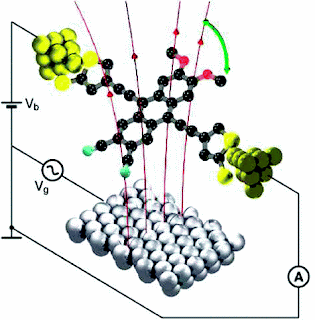http://www.scienceda...01029152751.htm
Advance Could Change Modern Electronics
ScienceDaily (Oct. 31, 2010)
— Researchers at Oregon State University have solved a quest in fundamental material science that has eluded scientists since the 1960s, and could form the basis of a new approach to electronics.

The discovery, just reported online in the professional journal Advanced Materials, outlines the creation for the first time of a high-performance "metal-insulator-metal" diode.
"Researchers have been trying to do this for decades, until now without success," said Douglas Keszler, a distinguished professor of chemistry at OSU. "Diodes made previously with other approaches always had poor yield and performance.
"This is a fundamental change in the way you could produce electronic products, at high speed on a huge scale at very low cost, even less than with conventional methods," Keszler said. "It's a basic way to eliminate the current speed limitations of electrons that have to move through materials."
A patent has been applied for on the new technology, university officials say. New companies, industries and high-tech jobs may ultimately emerge from this advance, they say.
The research was done in the Center for Green Materials Chemistry, and has been supported by the National Science Foundation, the Army Research Laboratory and the Oregon Nanoscience and Microtechnologies Institute.
Conventional electronics made with silicon-based materials work with transistors that help control the flow of electrons. Although fast and comparatively inexpensive, this approach is still limited by the speed with which electrons can move through these materials. And with the advent of ever-faster computers and more sophisticated products such as liquid crystal displays, current technologies are nearing the limit of what they can do, experts say.
By contrast, a metal-insulator-metal, or MIM diode can be used to perform some of the same functions, but in a fundamentally different way. In this system, the device is like a sandwich, with the insulator in the middle and two layers of metal above and below it. In order to function, the electron doesn't so much move through the materials as it "tunnels" through the insulator -- almost instantaneously appearing on the other side.
"When they first started to develop more sophisticated materials for the display industry, they knew this type of MIM diode was what they needed, but they couldn't make it work," Keszler said. "Now we can, and it could probably be used with a range of metals that are inexpensive and easily available, like copper, nickel or aluminum. It's also much simpler, less costly and easier to fabricate."
The findings were made by researchers in the OSU Department of Chemistry; School of Electrical Engineering and Computer Science; and School of Mechanical, Industrial and Manufacturing Engineering.
In the new study, the OSU scientists and engineers describe use of an "amorphous metal contact" as a technology that solves problems that previously plagued MIM diodes. The OSU diodes were made at relatively low temperatures with techniques that would lend themselves to manufacture of devices on a variety of substrates over large areas.
OSU researchers have been leaders in a number of important material science advances in recent years, including the field of transparent electronics. University scientists will do some initial work with the new technology in electronic displays, but many applications are possible, they say.
High speed computers and electronics that don't depend on transistors are possibilities. Also on the horizon are "energy harvesting" technologies such as the nighttime capture of re-radiated solar energy, a way to produce energy from the Earth as it cools during the night.
"For a long time, everyone has wanted something that takes us beyond silicon," Keszler said. "This could be a way to simply print electronics on a huge size scale even less expensively than we can now. And when the products begin to emerge the increase in speed of operation could be enormous."
And in other news:
ACS Nano - An All-Electric Single-Molecule Motor
Many types of molecular motors have been proposed and synthesized in recent years, displaying different kinds of motion, and fueled by different driving forces such as light, heat, or chemical reactions. We propose a new type of molecular motor based on electric field actuation and electric current detection of the rotational motion of a molecular dipole embedded in a three-terminal single-molecule device. The key aspect of this all-electronic design is the conjugated backbone of the molecule, which simultaneously provides the potential landscape of the rotor orientation and a real-time measure of that orientation through the modulation of the conductivity. Using quantum chemistry calculations, we show that this approach provides full control over the speed and continuity of motion, thereby combining electrical and mechanical control at the molecular level over a wide range of temperatures. Moreover, chemistry can be used to change all key parameters of the device, enabling a variety of new experiments on molecular motors.
Now they can use electric fields to spin the motor, akin to the macro scale motors we have today.
China Has the Worlds Most Powerful Supercomputer and it is Nvidia PoweredThe computer, known as Tianhe-1A, has 1.4 times the horsepower of the current top computer, which is at a national laboratory in Tennessee, as measured by the standard test used to gauge how well the systems handle mathematical calculations, said Jack Dongarra, a University of Tennessee computer scientist who maintains the official supercomputer rankings.
Although the official list of the top 500 fastest machines, which comes out every six months, is not due to be completed by Mr. Dongarra until next week, he said the Chinese computer “blows away the existing No. 1 machine.” He added, “We don’t close the books until Nov. 1, but I would say it is unlikely we will see a system that is faster.”
Artificial General Intelligence Toddler Project Needs $25 million
Ben Goertzel has finished writing the last chapter of his co-authored two-volume book on how to create beneficial human-level AGI, Building Better Minds (expected 2011 publish date)
The last chapter describes, in moderate detail, how the CogPrime cognitive architecture (implemented in the OpenCog open-source framework) would enable a robotic or virtual embodied system to appropriately respond to the instruction "Build me something surprising out of blocks." This is in the spirit of the overall idea: Build an AGI toddler first, then teach it, study it, and use it as a platform to go further.
From an AGI toddler, I believe, one could go forward in a number of directions: toward fairly human-like AGIs, but also toward different sorts of minds formed by hybridizing the toddler with narrow-AI systems carrying out particular classes of tasks in dramatically transhuman ways.
Edited by Elus, 31 October 2010 - 07:05 PM.
From nature to robot, Festo's bionic approach to engineering is garnering awards.














































